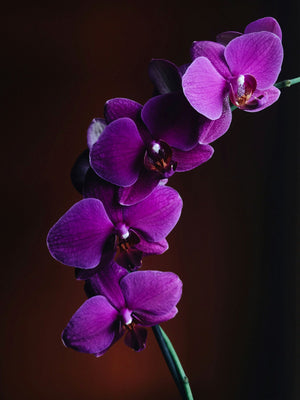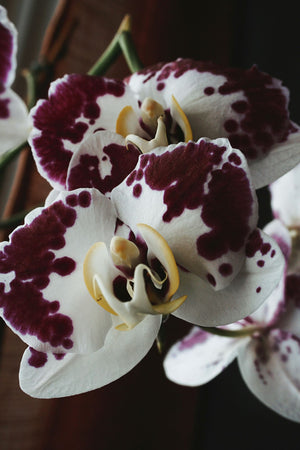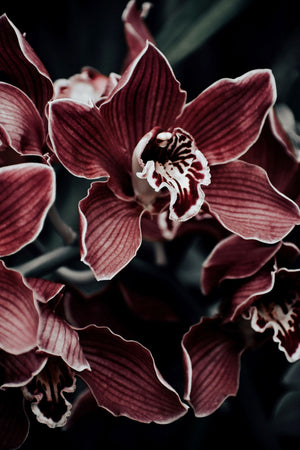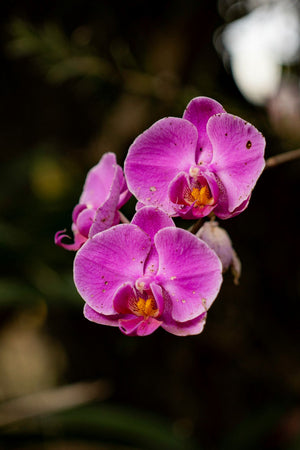The Orchid Guide
Orchids, renowned for their exotic beauty and intricate blooms, bring a touch of elegance and sophistication to any garden or indoor space. With their stunning flowers and diverse forms, Orchid plants are perfect for adding an eye-catching focal point to containers, hanging baskets, and interior decor. These plants are admired for their unique appearance and the variety of species available. Whether you're aiming to enhance your indoor plant collection, create a vibrant garden display, or add a unique element to your space, Orchids offer a captivating and versatile solution. Explore our Orchid Guide to learn more about cultivating and caring for these fascinating plants, and discover how to incorporate them into your garden or indoor spaces for lasting beauty and enjoyment.

About
Orchids belong to the Orchidaceae family, one of the largest and most diverse plant families in the world, comprising over 25,000 species and more than 100,000 hybrids. These plants are native to almost every habitat on Earth, from tropical rainforests to arid deserts, making them incredibly adaptable and varied. The name "Orchid" is derived from the Greek word "orchis," meaning testicle, a reference to the shape of the plant's tubers.
Orchids are known for their complex and stunning flowers, which come in a wide range of shapes, sizes, and colors. The flowers often have a unique structure, including three petals and three sepals, with one petal typically forming a distinctive lip or labellum. This specialized structure is designed to attract pollinators, making Orchids fascinating examples of evolutionary adaptation.
Some of the most popular Orchid genera include Phalaenopsis (Moth Orchids), Dendrobium, Cattleya, Oncidium, and Vanda. Each genus has its unique characteristics and care requirements, but all Orchids share the common trait of producing beautiful and long-lasting flowers.
Orchids are epiphytic or terrestrial in nature. Epiphytic Orchids grow on trees or rocks, using their aerial roots to absorb moisture and nutrients from the air and rain. Terrestrial Orchids grow in the ground, often in well-draining, organic-rich soil. Their diverse growth habits make them suitable for various growing conditions, both indoors and outdoors.

Planting
Providing the right environment is crucial to the success of your Orchids. With proper conditions, these plants will reward you with stunning flowers and lush growth.
- Soil: Orchids require a well-draining potting mix that allows air to reach their roots. For epiphytic Orchids, use a mix of bark, sphagnum moss, and perlite or charcoal. Terrestrial Orchids thrive in a mix of peat moss, perlite, and sand. Avoid using regular potting soil, which can retain too much moisture and cause root rot.
- Light: Orchids thrive in bright, indirect light. While they can adapt to various light levels, their growth and flowering will be more vigorous with adequate light. Avoid direct sunlight, which can scorch the leaves, especially for indoor plants.
- Watering: Orchids require regular watering to keep the potting mix evenly moist but not waterlogged. Water the plant thoroughly, allowing excess water to drain away. For most Orchids, it is best to water once a week, adjusting based on the humidity and temperature of the environment. Reduce watering in the winter months when the plant's growth slows down.
- Humidity: Orchids prefer high humidity levels, typically between 50-70%. Increase humidity by misting the leaves regularly, placing a humidifier nearby, or using a pebble tray with water. This is particularly important for indoor plants, especially in dry environments.
- Temperature: Orchids thrive in temperatures between 60-80°F (16-27°C). Ensure a temperature drop of about 10°F (5°C) at night to encourage flowering. Protect the plant from cold drafts and sudden temperature changes, which can cause stress and damage the leaves.
- Containers: Choose a pot with drainage holes to prevent waterlogging. Clear plastic pots are often recommended for Orchids, as they allow light to reach the roots and make it easier to monitor root health. Ensure the container is large enough to accommodate the plant's root system and allows for growth.

Care
With the proper care, Orchids will thrive and produce stunning blooms that last for weeks or even months. Follow these care tips to maintain your Orchids’ health and beauty:
- Watering: Keep the potting mix consistently moist but not waterlogged. Water the plant thoroughly, allowing excess water to drain away. For most Orchids, water once a week, adjusting based on the humidity and temperature of the environment. Avoid using hard water, which can cause mineral buildup on the roots.
- Fertilizing: Orchids benefit from regular feeding during the growing season. Use a balanced, water-soluble fertilizer specifically formulated for Orchids, diluted to half strength every 2-4 weeks from spring through fall. Avoid over-fertilizing, as this can lead to salt buildup and damage the plant.
- Pruning: Remove any yellow or damaged leaves to maintain the plant's appearance and health. Use clean, sharp scissors to avoid introducing infections. After the flowers fade, trim the flower spike back to a node or the base to encourage new growth and flowering.
- Pests and Diseases: Orchids can be susceptible to pests such as spider mites, aphids, and mealybugs. Inspect your plants regularly and treat any infestations promptly with appropriate organic or chemical controls. Maintain proper watering and humidity to reduce the risk of pests and diseases.
- Repotting: Repot Orchids every 1-2 years or when they outgrow their current container. Spring is the best time to repot. Use fresh potting mix and ensure the new pot has adequate drainage. Repotting helps refresh the growing medium and provides space for new growth.

How To Use
Orchids’ exotic blooms and adaptable growth habits make them a versatile choice for enhancing indoor and outdoor spaces. Explore these creative uses:
- Indoor Decor: Orchids make stunning houseplants, adding a touch of elegance to any room. Place them in bright, indirect light and use decorative pots to enhance their appearance. Their exotic flowers and architectural form make them a striking focal point in any interior setting.
- Office Plants: Orchids' ability to thrive in bright, indirect light makes them ideal for office environments. Place them on desks, shelves, or in corners to bring a touch of nature to the workspace. Their air-purifying properties also help improve indoor air quality.
- Hanging Baskets: Smaller Orchid species or varieties with trailing habits can be grown in hanging baskets to create cascading displays of blooms. This is an excellent way to showcase their unique flowers and add visual interest to your indoor or outdoor spaces.
- Living Walls: Use Orchids to create living wall displays. Plant them in vertical planters or frames to add a unique, textural element to indoor or outdoor walls. Their exotic blooms can enhance the visual appeal of vertical gardens.
- Patios and Balconies: Grow Orchids in containers to create portable displays for patios, balconies, or entryways. Use decorative pots to enhance their sculptural forms and arrange them in groupings for added impact.
- Terrariums: Small Orchid plants can be used in terrariums, where their humidity needs can be easily met. Combine them with other tropical plants to create a lush, miniature ecosystem.
- Public Spaces: Orchids are often used in public spaces like hotel lobbies, restaurants, and office buildings to create a luxurious, inviting atmosphere. Their striking appearance and long-lasting blooms make them ideal for such settings.
Conclusion
Orchids are a captivating and versatile addition to any garden or indoor space. With their exotic flowers, diverse forms, and minimal maintenance requirements, Orchid plants bring a touch of elegance and sophistication to your environment. Their adaptability to various growing conditions and ease of care make them a favorite among gardeners and indoor plant enthusiasts of all levels. By following proper planting and maintenance techniques, you can fully harness the potential of Orchids to enhance your garden and home, creating a lasting impact.
Whether you seek to create stunning indoor displays, enhance your patio garden, or add visual interest to hanging baskets and living walls, Orchids can fulfill a variety of roles in your landscape and decor. Place them individually to showcase their unique beauty, or combine different species and varieties for a dynamic and visually appealing display. Orchids' ability to thrive in diverse environments and provide year-round interest adds to their appeal, making them a valuable addition to any collection.
Beyond their ornamental value, Orchids contribute to the overall health and beauty of your garden ecosystem by providing habitat for beneficial insects and adding structure to your landscape. Their low maintenance requirements and resilience make them an excellent choice for sustainable gardening. With their enduring beauty, versatility, and ecological benefits, Orchid plants bring natural allure and vibrant charm to your outdoor and indoor environments, enriching your plant collection and enhancing the overall beauty of your space.









